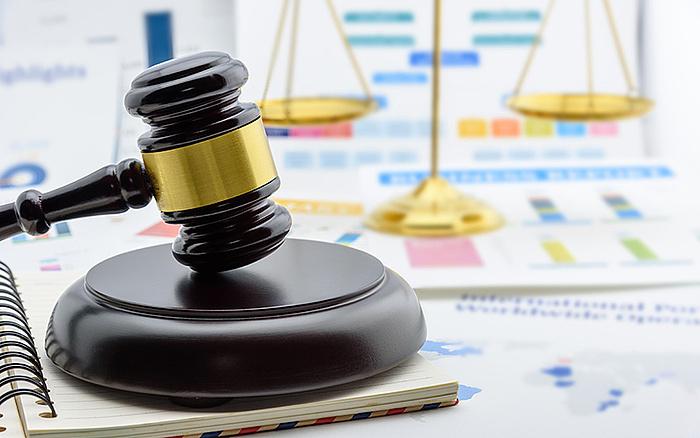
Setting the record straight on patent infringement and damages
In 2023, over 400 patent infringement cases were filed in the United States alone. The time, money and energy involved in litigation only emphasizes the critical need to understand the legal details of patents. However, navigating this area can be complex and may seem overwhelming to innovators and businesses.
We break down what patent infringement is, the potential consequences and some steps to help avoid or defend against court actions. If you are in the innovation space, knowledge is key.
What exactly is patent infringement?
Patents are one of the main types of Intellectual Property (IP), granting holders exclusive rights to an invention's manufacture, use, sale and import in a particular jurisdiction for a limited time. Thus, patent infringement occurs when an individual or commercial entity carries out one or more of these actions during this period without the permission of the patent holder.
Just as inventions are often highly technical, so too is the law governing their ownership and compensation deeply nuanced. For instance, the issue of which acts constitute infringement is not fully harmonized and remains a question of national law. Here is a concise breakdown of three forms of patent infringement, each carrying its specific threshold.
- Direct infringement: This occurs when a conflicting product or process reproduces one or more claims of an active patent. It means that the patented invention has been used, sold or manufactured, in whole or in part, without the owner's consent. Direct patent infringement does not require knowledge or intent.
- Contributory infringement: This refers to situations where a person or entity offers a component that then becomes a material part of a patented invention, knowing it is apt to infringe exclusive rights. For contributory infringement to be valid, there must be direct infringement by another party. In essence, it involves supplying a crucial part of a patented process or product.
- Induced infringement: When an entity or individual encourages, aids or causes another to infringe a patent, it is called induced infringement. This violation requires evidence that the accused genuinely and knowingly suborned the act.

Unlike with copyrights, patent infringement does not necessarily involve deliberate imitation or replication. Even an independently generated invention could infringe existing patents in a given jurisdiction. Thus, inventors need to be vigilant against committing even accidental violations.
Real cases of patent infringement
1. Carnegie Mellon University vs. Marvell Technology Group
In this notable case, a U.S. federal jury in Pittsburgh, Pennsylvania, ruled in 2012 that Marvell Technology Group infringed on two patents owned by Carnegie Mellon University (CMU). These patents pertained to enhancing the precision of hard-drive data readings. Shortly after the 2012 decision, Marvell Technology was ordered to pay CMU a whopping $1.54 billion USD. However, the Court of Appeals for the Federal Circuit later reduced this amount to a minimum of $278 million USD and mandated a retrial on other damages-related issues. By 2016, instead of prolonging the litigation, both parties agreed to a settlement of $750 million USD.
2. Altana Pharma AG et al. vs. Teva Pharmaceuticals USA Inc. et al.
This case marked a pivotal moment in the pharmaceutical world. Generic drug manufacturers Teva Pharmaceuticals and Sun Pharmaceutical Industries found themselves in a tight spot for launching versions of Pfizer's heartburn medication Protonix before its patent expired in 2011. This approach is often referred to as an "at-risk" launch. The outcome? The defendants agreed to pay $2.15 billion USD to settle the dispute. Breaking it down, Teva would pay $1.6 billion USD and Sun Pharma $550 million USD. It is worth noting that the relevant patent was originally held by Altana Pharma AG and then purchased by a subsidiary of the Takeda Pharmaceutical Company, Nycomed, who licensed it to Pfizer-owned Wyeth. Hence, the parent companies split the payment, with Pfizer receiving 64% and Takeda the remainder.
3. Polaroid vs. Kodak
While this case originated in the mid-1970s, it remains one of the most impactful patent disputes to date. Polaroid took Kodak to court in 1976, accusing the latter of infringing on 12 patents related to instant photography. The now-defunct pioneer of instant cameras and film sought an eye-watering $12 billion USD in damages, a staggering sum even by modern standards. In October 1990, Kodak was directed to pay Polaroid damages of $909 million USD. This amount was later adjusted to $925 million USD, including interest. The two companies finally buried the hatchet under this monumental sum in July 1991, agreeing to drop all appeals to the 1990 federal ruling.

The complexity of high-value inventions means infringement lawsuits can be especially lengthy as the relevant patents are examined in minute detail. Such protracted litigation is always expensive, meaning it is often a top priority of the winning party to recover its costs in judgment.
Consequences of patent infringement
Losing a patent infringement lawsuit can significantly impact operations and profitability in a number of ways.
- Financial penalties: The most immediate outcome of an upheld patent infringement case is the imposition of monetary damages. This recompense can be based on the profits made off the back of the infringement, the revenue lost to the patent owner, non-court expenses incurred by the patent owner or a combination of these factors. A court may separately order the losing party to pay the other's legal costs.
- Injunctions: Beyond paying damages, losing parties may also be ordered to stop producing or selling the infringing product or service. This order, known as an injunction, can have long-term implications for a business – halting production lines or entire service offerings.
- Heightened damages: The concept of willful infringement comes into play when an entity knowingly violates a patent right. If the violation is determined to be intentional, the awarded damages can be tripled in the United States. This was one reason why Polaroid's demanded figure was so high. However, this provision is not universal. In the United Kingdom, for instance, damages are purely compensatory rather than punitive.
- Reputational damage: An often overlooked yet serious repercussion is the potential damage to a company's standing. Infringing on someone else's IP can erode trust among customers, partners and stakeholders. It can mar a business as unoriginal or untrustworthy, making it challenging to build or restore brand credibility.
- Loss of business opportunities: In the same vein, other businesses might be hesitant to collaborate or partner with an entity known for patent violations, limiting growth prospects and market expansions. This can also deter customers who prefer to patronize companies that maintain high ethical and legal standards.

Being found liable for patent infringement can seriously stifle a business's finances in the immediate- and long terms. Adding to the strain of hefty bills and fines, strategic partnerships could dissolve or even fail to materialize in light of an untrustworthy reputation.
Strategies to avoid patent infringement
As we have seen, patent infringement poses substantial risks, both monetarily and functionally. But prevention is better than cure, and with the right practices in place, businesses and individuals can greatly mitigate the danger of making a costly misstep.
Firstly, before launching a new product or service, you may consider carrying out a thorough freedom-to-operate (FTO) search. This step can help identify any existing patents that might be related to your invention, ensuring you do not inadvertently infringe upon someone else's patent rights. However, even a thorough FTO search only identifies potentially relevant patents. Early identification of such grants and pending applications may give time to consider a workaround to avoid infringing on their claims.
- Licensing and cross-licensing: Cooperation is often an effective innovation strategy. By entering into licensing agreements with patent owners, the risk of infringing their technology is removed. Mutually beneficial cross-licensing allows both parties to use certain aspects of the other's patents to boost development.
- Maintaining detailed records: Always keep detailed documentation of your inventive process, from concept to launch. These records can be invaluable as evidence of independent development should an infringement claim arise.
- Staying updated with legal precedents: Patent laws and regulations are not static. Keeping abreast of precedential legal decisions can offer insights into how the courts are interpreting certain aspects, which can guide your IP strategy, particularly with regard to technologies in advanced fields such as software and genetics.
- Conducting in-house IP training: Training sessions for employees, especially those in research and development roles, can be advantageous. This makes sure everyone understands the value of patents, thereby reducing the likelihood of accidental infringement.
- Engaging a patent attorney: Keeping a patent attorney onboard for regular consultations provides an external expert viewpoint. They can offer specialized advice and ensure compliance with patent laws.

The most efficient strategy for your company will likely involve a combination of anti-infringement plans and may evolve. For instance, training could be a focus during early growth stages. However, no matter a business's size or maturation, in-house or external legal counsel is always invaluable.
Yet, despite these preventative measures, there might still be unforeseen challenges. Accusations of patent infringement can appear even when you have been following best practices. In the case of a wrongful suit, navigating the situation requires a deep understanding of the specifics of the patent claims in question and the contested product or service. Thankfully, with expert representation, defendants are well equipped to rebuff spurious allegations:
- Prior-use defense: This involves demonstrating that your use of a patented invention took place before the patent's priority date.
- Invalidity defense: This challenges the validity of the asserted patent or certain claims therein. If successful, the patent will be revoked in part or entirely.
- And more: Several other defenses can be employed based on the specifics of the case, including proving non-infringement, lack of jurisdiction or unenforceability.
Elevate your IP strategy
With 60 years of industry experience, Dennemeyer stands as a trusted partner in IP strategy and management. Our resources and expertise provide a streamlined approach to safeguarding your rights and empowering your innovation.
Partner with Dennemeyer for results-driven, client-centric patent solutions.
Filed in

How accurate were past forecasts about IP in 2025? We revisit the EPO's 2007 study, exploring its boldest scenario where public funding and open access challenge the patent system.



